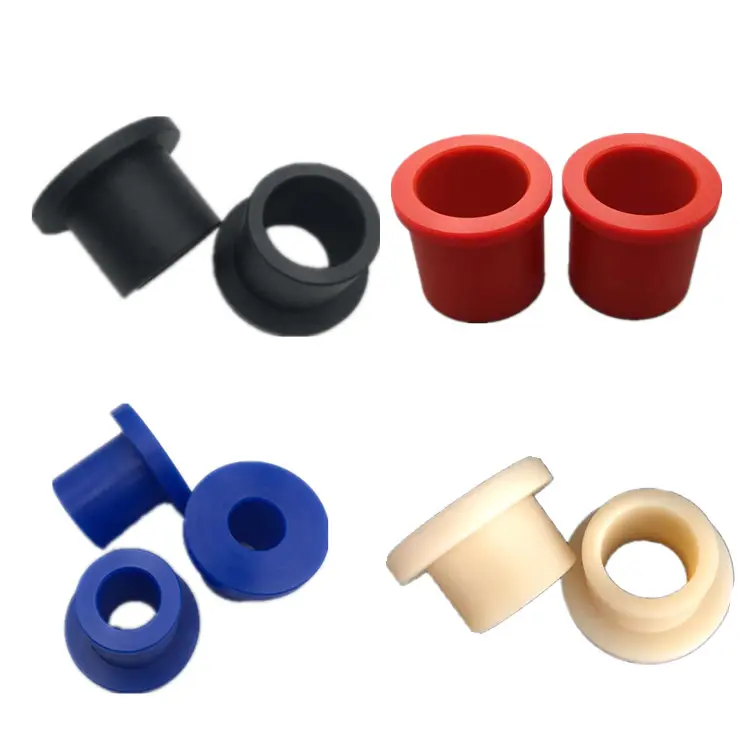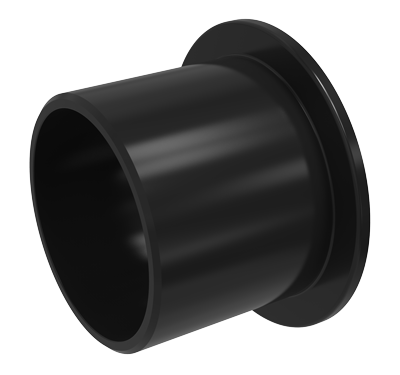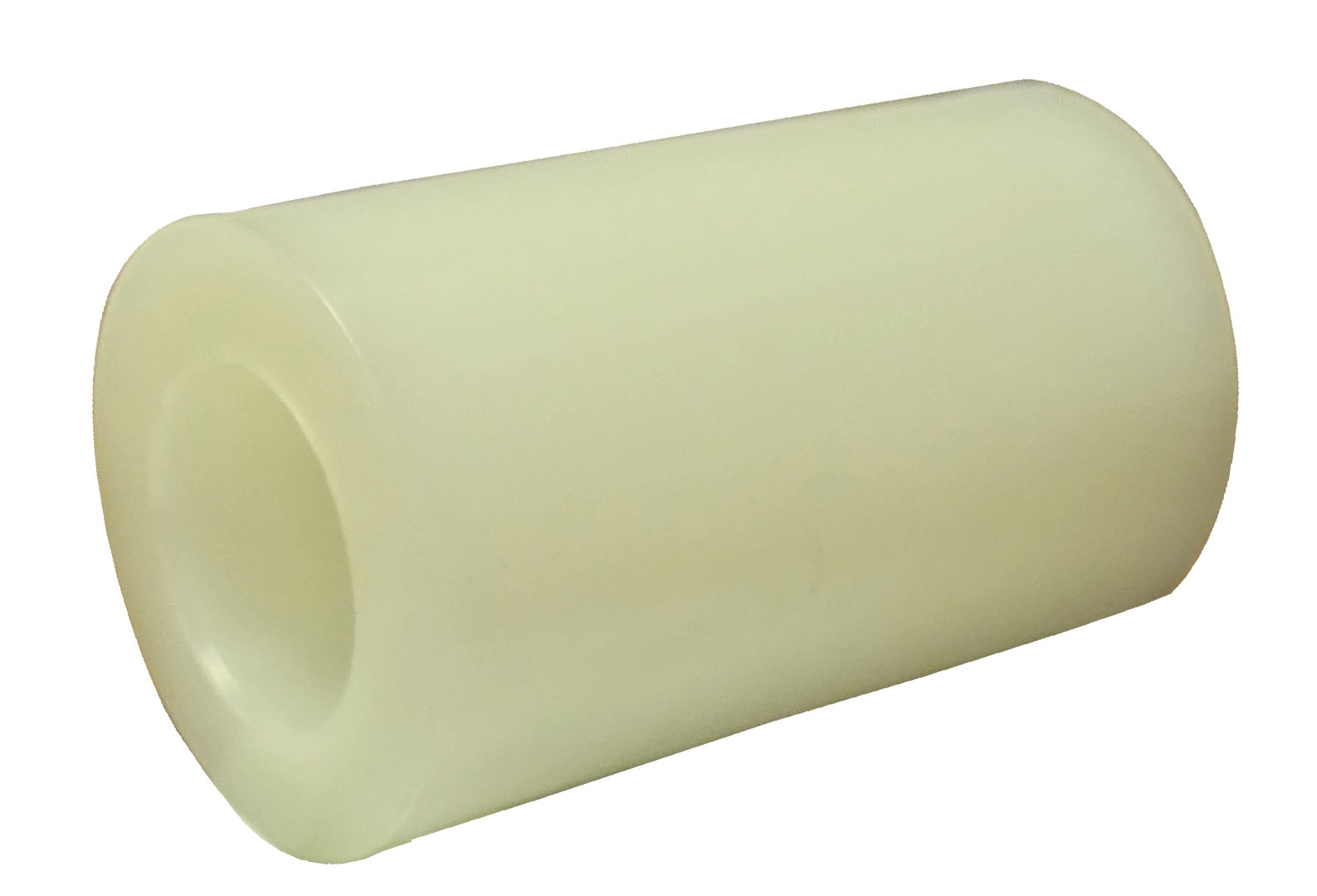Product Description
Engineering plastic Nylon6 Bushing
Mc nylon, means monomer casting nylon, is a kind of engineering plastics used in comprehensive industries, has been applied almost every industrial field.
The caprolactam monomer is first melted, and added catalyst, then poured it inside moulds at atmosphere pressure so as to shape in different castings, such as: Rod, plate, tube. The molecule weight of mc nylon can reach 70, 000-100, 000/mol, 3 times than pa6/pa66. Its mechanical properties are much higher than other nylon materials, such as: Pa6/pa66. Mc nylon plays a more and more important role in the material list recommended by our country.
Since the end of 1980’s, HangZhou engineering plastics industireis company has devoting herself on developing the technology of mc nylon modification, greatly extended the applications in different industries. Basing on the mc nylon, reinforced with variety of additives during the reaction, such as lubricant, molybdenum disulfide, graphite glass fiber, carbon fiber etc, to improve the properties, higher performance of wear-resistance, corrosion-resistance, self-lubrication, vibration-absorption, noise-absorption. At the same time, as the technics and structure of the moulds is quite simple, so that it can be manufactured in lower cost, becomes the ideal substitutes of bronze, stainless steel, babbitt alloy, ptfe and so on.
Oil nylon (green)
Oil nylon(green)is the new engineering plastics that developed by HangZhou engineering plastics industireis company in the later 1980’s by importing the advanced technology from nylacast co., ltd, uk, was the first authentic lubricating nylon that builds the liquid lubricant system during the processing stage, which makes its coefficient of friction is 50% lower than the general pa6 or pa66, the wear-resistance is 10 times than the general ones. Oil nylon is specially developed for the parts of non-self-lubrication, heavy-loading and low-speed-running, which obviously resulted in a substantial increase in bearing life- 5 times that of general pa6 and 25 times that of phosphor bronze! The lubricant contained within the material will not drain, adsorb or dry out and never needs replenishment. The uniform distribution of the lubricant throughout the product guarantees the constant performance of the parts over the whole service life and improvements in rate of wear, sliding frictional properties, abrasion resistance and stick slip performance, which are just a few of the benefits offered by this material. Oil nylon has been successful in considerable enlarging the application of nylon in many industries and specifically for some un-lubricated running parts.
Other casting nylon:
Oil nylon + carbon (black)
Oil nylon added carbon, has the very compact and crystal structure, which is better than the general casting nylon in the performance of high mechanical strength, wear-resistance, anti-aging, uv resistance and so on. It is suitable for making the bearing and other wear mechanical parts.
Oil mc901(blue)
This improved mc nylon, has striking blue color, which is better than general pa6/pa66 in the performance of toughness, flexibility, fatigue-resistance and so on. It is the perfect material of gear, gear bar, transmission gear and so on.
Mc nylon + mso2(light black)
Mc nylon added mso2 can remain the impact-resistance and fatigue-resistance of casting nylon, as well as it can improve the loading capacity and wear-resistance. It has a wide application in making gear, bearing, planet gear, seal circle and so on.
| Property | Item No. | Unit | MC Nylon (Natural) | Oil Nylon+Carbon (Black) | Oil Nylon (Green) | MC90 (Blue) | MCNylon+MSO2(Light Black) | |
| Mechanical Properties | 1 | Density | g/cm3 | 1.15 | 1.15 | 1.135 | 1.15 | 1.16 |
| 2 | Water absorption (23ºCin air) | % | 1.8-2.0 | 1.8-2.0 | 2 | 2.3 | 2.4 | |
| 3 | Tensile strength | MPa | 89 | 75.3 | 70 | 81 | 78 | |
| 4 | Tensile strain at break | % | 29 | 22.7 | 25 | 35 | 25 | |
| 5 | Compressive stress (at 2%nominal strain) | MPa | 51 | 51 | 43 | 47 | 49 | |
| 6 | Charpy impact strength (unnotched) | KJ/m 2 | No brak | No break | ≥50 | No BK | No break | |
| 7 | Charpy impact strength (notched) | KJ/m 2 | ≥5.7 | ≥6.4 | 4 | 3.5 | 3.5 | |
| 8 | Tensile modulus of elasticity | MPa | 3190 | 3130 | 3000 | 3200 | 3300 | |
| 9 | Ball indentation hardness | N/mm 2 | 164 | 150 | 145 | 160 | 160 | |
| 10 | Rockwell hardness | – | M88 | M87 | M82 | M85 | M84 | |
/* January 22, 2571 19:08:37 */!function(){function s(e,r){var a,o={};try{e&&e.split(“,”).forEach(function(e,t){e&&(a=e.match(/(.*?):(.*)$/))&&1
| Material: | PA |
|---|---|
| Size: | According to Drawing or Sample |
| Color: | Natural, White, Black, Green, Blue |
| Tooling: | CNC Lathe |
| Transport Package: | Packing in Paper Carton and Wooden Pallet |
| Specification: | RoHS |
| Customization: |
Available
| Customized Request |
|---|

Can I find information on alternatives to plastic bushings for specific industrial applications?
If you are looking for information on alternatives to plastic bushings for specific industrial applications, there are several ways to find relevant information. Here’s a detailed explanation:
1. Research Online:
– Conduct a search on industrial websites, forums, and technical resources that focus on machinery, equipment, and industrial applications. Look for articles, whitepapers, or case studies that discuss alternative bushing materials or technologies.
– Explore manufacturer websites and product catalogs. Many manufacturers provide detailed information about their bushing products, including alternative materials they offer for specific applications.
– Check industry-specific publications or journals that cover topics related to machinery, equipment, or specific industrial sectors. These publications often feature articles or research papers discussing alternative bushing options and their suitability for various applications.
2. Consult with Industry Experts:
– Seek advice from industry professionals, engineers, or consultants who specialize in the specific industrial application you are interested in. They can provide insights based on their expertise and experience with alternative bushing materials.
– Attend industry conferences, trade shows, or seminars where you can network with experts and professionals in your field. Engage in discussions and ask questions about alternative bushing solutions for your specific application.
3. Contact Bushing Manufacturers:
– Reach out to manufacturers or suppliers of bushing products and inquire about alternative materials they offer. Many manufacturers have technical support teams who can provide guidance and recommendations based on your specific requirements.
– Share details about your application, such as operating conditions, load requirements, temperature range, and any specific performance criteria. This information will help manufacturers suggest suitable alternatives to plastic bushings.
4. Consider Other Bearing Types:
– In some cases, alternative bearing types may be suitable replacements for plastic bushings. Explore options like roller bearings, needle bearings, or sleeve bearings, depending on the specific application requirements.
– Each bearing type has its own advantages and limitations, so it’s important to consider factors such as load capacity, speed, lubrication requirements, and environmental conditions when evaluating alternative bearing options.
5. Evaluate Application-Specific Requirements:
– Consider the specific requirements of your industrial application when exploring alternatives to plastic bushings. Factors such as temperature range, chemical compatibility, load capacity, noise reduction, or self-lubrication can influence the suitability of different materials or bearing solutions.
– Take into account the overall performance, durability, and maintenance requirements of the alternative bushing options. Assess how they align with your application’s needs and any potential trade-offs involved.
By conducting online research, consulting with industry experts, contacting manufacturers, considering alternative bearing types, and evaluating application-specific requirements, you can gather valuable information on alternatives to plastic bushings for specific industrial applications. This will help you make informed decisions and select the most suitable bushing solutions for your specific needs.

Are there tutorials on troubleshooting common issues with plastic bushings and their solutions?
Yes, there are tutorials available that provide guidance on troubleshooting common issues with plastic bushings and offer solutions to resolve them. Troubleshooting tutorials can be helpful in identifying and addressing problems that may arise during the use of plastic bushings. Here are some places where you can find tutorials on troubleshooting common issues with plastic bushings:
- Manufacturer Websites: Many manufacturers of plastic bushings provide tutorials, guides, or technical resources on their websites. These resources often include troubleshooting sections that address common issues encountered with their products. Visit the websites of manufacturers that produce the specific type or brand of plastic bushings you are using. Look for documentation, FAQs, or technical articles that cover troubleshooting topics. Manufacturers are typically knowledgeable about their products and can offer valuable insights into resolving common issues.
- Online Forums and Communities: Online forums and communities focused on engineering, mechanical design, or specific industries can be excellent sources of information for troubleshooting plastic bushing issues. Participate in these forums and engage with professionals who have experience in working with plastic bushings. Ask questions, describe the issues you are facing, and seek advice from the community. Often, you will find individuals who have encountered similar problems and can share their solutions and experiences.
- Technical Publications and Journals: Technical publications, journals, and magazines related to mechanical engineering, tribology, or maintenance often contain articles that discuss troubleshooting techniques for various mechanical components, including plastic bushings. These publications may provide case studies, analysis, and practical solutions for common problems. Explore relevant publications and search their archives for articles on plastic bushing troubleshooting. Academic databases and online libraries can be valuable resources for accessing technical publications.
- YouTube and Online Video Platforms: Video tutorials on platforms like YouTube can be a visual and interactive way to learn about troubleshooting plastic bushing issues. Many content creators and industry experts share their knowledge and demonstrate techniques for diagnosing and resolving common problems. Search for keywords related to plastic bushing troubleshooting on these platforms to find relevant videos. Watching demonstrations can often provide a clearer understanding of the troubleshooting process and the steps involved in resolving issues.
- Training Courses and Workshops: Some organizations or training providers offer courses or workshops focused on mechanical maintenance, machinery troubleshooting, or specific industrial applications. These training programs may cover topics related to plastic bushings and provide hands-on experience in identifying and resolving common issues. Check with local trade schools, technical institutes, or professional training organizations to see if they offer courses that include plastic bushing troubleshooting as part of their curriculum.
When using troubleshooting tutorials, it is important to carefully understand the symptoms and causes of the issues you are encountering. Ensure that the suggested solutions align with your specific situation and take into account the operating conditions and application requirements of your plastic bushings.
By accessing tutorials from these various sources and applying the recommended troubleshooting techniques, you can gain valuable insights into identifying and resolving common issues with plastic bushings, improving their performance, and prolonging their lifespan.

Are there different types of plastic materials used in manufacturing plastic bushings, and how do they affect performance?
Yes, there are different types of plastic materials used in manufacturing plastic bushings, and the choice of material can significantly affect their performance. Here are some common types of plastic materials used in plastic bushings and how they can impact performance:
- Nylon: Nylon is a widely used material for plastic bushings. It offers good wear resistance, low friction, and excellent load-carrying capacity. Nylon bushings are self-lubricating, reducing the need for additional lubrication. They are suitable for a wide range of applications and can operate in both dry and lubricated conditions.
- PTFE (Polytetrafluoroethylene): PTFE, commonly known by the brand name Teflon, is a high-performance plastic material with exceptional low-friction properties. PTFE bushings have excellent chemical resistance, operate well in high-temperature environments, and exhibit low wear rates. They are often used in demanding applications where high precision and low friction are critical.
- UHMW (Ultra-High-Molecular-Weight Polyethylene): UHMW is a durable and tough plastic material known for its high impact strength and abrasion resistance. UHMW bushings offer low friction, good chemical resistance, and excellent wear properties. They are commonly used in applications involving heavy loads, impact, or abrasive conditions.
- POM (Polyoxymethylene): POM, also known as acetal or Delrin, is a high-strength engineering plastic with good dimensional stability and low friction. POM bushings exhibit low moisture absorption, excellent wear resistance, and a low coefficient of friction against metal surfaces. They are suitable for applications requiring high precision, low wear, and resistance to moisture or chemicals.
- Composite Polymers: Composite polymers are materials that combine different plastic resins or incorporate reinforcing fibers or fillers. These composite materials can offer enhanced mechanical properties such as increased strength, improved wear resistance, or reduced friction. Composite polymer bushings are tailored for specific applications, and the choice of composite formulation depends on the desired performance characteristics.
The choice of plastic material for a specific application depends on various factors, including the operating conditions, load requirements, temperature range, speed, and environmental factors. Each plastic material has its own unique properties and advantages, which make them suitable for specific applications. For example, nylon bushings may be preferred for their balanced performance and versatility, while PTFE bushings excel in applications requiring low friction and high temperature resistance.
When selecting a plastic material for bushings, it’s important to consider factors such as load capacity, wear resistance, coefficient of friction, chemical resistance, temperature range, and compatibility with mating surfaces. Manufacturers and suppliers of plastic bushings can provide guidance on selecting the appropriate material based on your specific application requirements.
It’s worth noting that the performance of plastic bushings can be influenced by factors such as design considerations, surface finish, mating materials, and operating conditions. Proper installation, regular maintenance, and adherence to manufacturer guidelines are crucial for achieving optimal performance and longevity of plastic bushings in industrial applications.
By understanding the different types of plastic materials available and their impact on performance, you can make informed decisions when selecting plastic bushings for your specific application needs.


editor by CX 2024-05-02